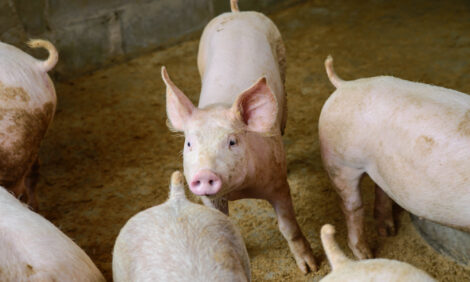



Russia Takes Steps to Strengthen its Meat Sector
US - Russia’s combined beef, pork, and poultry imports reached $2.1 billion in 2002, approaching the record level of $2.5 billion set in 1997, according to its trade statistics.
Russia Takes Steps to Strengthen its Meat Sector - US - Russia’s combined beef, pork, and poultry imports reached $2.1 billion in 2002, approaching the
record level of $2.5 billion set in 1997, according to its trade statistics.
Poultry imports grew rather strongly despite the month-long ban and extended trade disputes with the United States, its largest supplier. Russia’s combined meat imports accounted for over 40 percent of consumption in 2002.
The introduction of import quotas will likely reduce reliance on foreign meat supplies and stimulate domestic production.
For 2003, Russia’s total meat production (beef, pork, broilers, and turkey) is forecast to increase 5 percent, totaling over 4.1 billion tons, but still less than half of the level seen in the Soviet era.
Effective April 1, beef and pork imports are subject to tariff-rate-quotas (TRQ’s) of 420,000 tons and 450,000 tons, respectively. In-quota duty is 15 percent for both beef and pork. Out-of-quota duties are 60 percent for beef and 80 percent for pork. Beef and pork TRQ’s will be in effect until 2010.
Beginning May 1, the poultry quota will be in place for the next 3-year period. All poultry product imports are allowed up to the 1.05 million ton quota at a 25-percent import duty. No additional poultry imports will be allowed once the quota is filled. For 2003, the annual poultry quota of 1.05 million tons will be prorated to 744,000 tons for the 8-month (May-December) period. The remainder of the 2003 quota of 306,000 tons will be filled in 2006.
After a decade-long slide, Russia’s total meat production started to rise in 2001. Poultry (broilers and turkey) production, the smallest meat sector, started its comeback trail after bottoming out in 1997. Since then, poultry production has shown annual double-digit growth.
Rapid growth in the poultry industry in recent years is attributed to broad-based private sector and government-induced investment. If growth were to continue at the current rate, Russia’s poultry production could reach the pre-FSU level within 5 years. Pork production is also growing 4 percent annually after bottoming out in 2000. If this rate of growth is sustained, it may take years for pork output to reach the level seen in Soviet times. However, beef production, once the largest meat sector, continues to decline.
Source: Foreign Agricultural Service, USDA - International Trade Report - 11th April 2003
|
$Billions Meat Market…
Largest gains were seen in pork imports, more than doubling the 2001 level to reach $690 million. Gains in beef imports were 15 percent to $591 million, compared to 8 percent in poultry imports to $819 million.Poultry imports grew rather strongly despite the month-long ban and extended trade disputes with the United States, its largest supplier. Russia’s combined meat imports accounted for over 40 percent of consumption in 2002.
The introduction of import quotas will likely reduce reliance on foreign meat supplies and stimulate domestic production.
For 2003, Russia’s total meat production (beef, pork, broilers, and turkey) is forecast to increase 5 percent, totaling over 4.1 billion tons, but still less than half of the level seen in the Soviet era.
…Lays out a Road Map for the Future
After the breakup of the Soviet Union in 1991, combined meat availability decreased about 50 percent during the 1990’s. Despite reduced production, the level of meat consumption was maintained due largely to stepped-up meat imports, mainly broilers, beginning in 1994. Since then, more than 70 percent of broiler consumption has depended on imports, while about 20 percent of beef and pork consumption dependence has been on imports. As reliance on meat imports for consumption remains large, imports have been an easy target for complaints by domestic producers as they began their comeback.
Effective April 1, beef and pork imports are subject to tariff-rate-quotas (TRQ’s) of 420,000 tons and 450,000 tons, respectively. In-quota duty is 15 percent for both beef and pork. Out-of-quota duties are 60 percent for beef and 80 percent for pork. Beef and pork TRQ’s will be in effect until 2010.
Beginning May 1, the poultry quota will be in place for the next 3-year period. All poultry product imports are allowed up to the 1.05 million ton quota at a 25-percent import duty. No additional poultry imports will be allowed once the quota is filled. For 2003, the annual poultry quota of 1.05 million tons will be prorated to 744,000 tons for the 8-month (May-December) period. The remainder of the 2003 quota of 306,000 tons will be filled in 2006.
After a decade-long slide, Russia’s total meat production started to rise in 2001. Poultry (broilers and turkey) production, the smallest meat sector, started its comeback trail after bottoming out in 1997. Since then, poultry production has shown annual double-digit growth.
Rapid growth in the poultry industry in recent years is attributed to broad-based private sector and government-induced investment. If growth were to continue at the current rate, Russia’s poultry production could reach the pre-FSU level within 5 years. Pork production is also growing 4 percent annually after bottoming out in 2000. If this rate of growth is sustained, it may take years for pork output to reach the level seen in Soviet times. However, beef production, once the largest meat sector, continues to decline.
Source: Foreign Agricultural Service, USDA - International Trade Report - 11th April 2003













